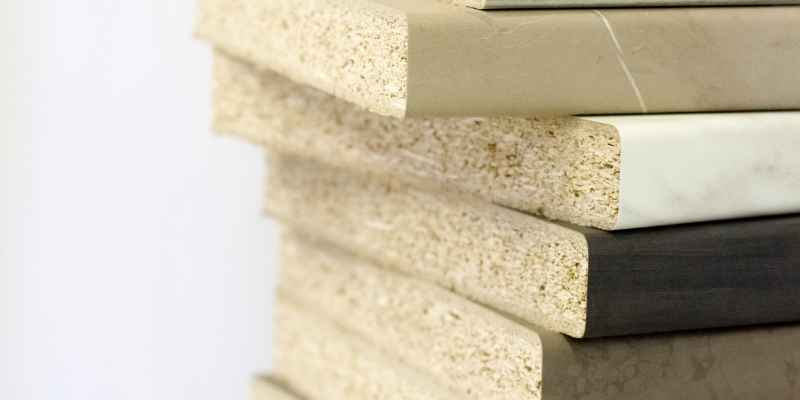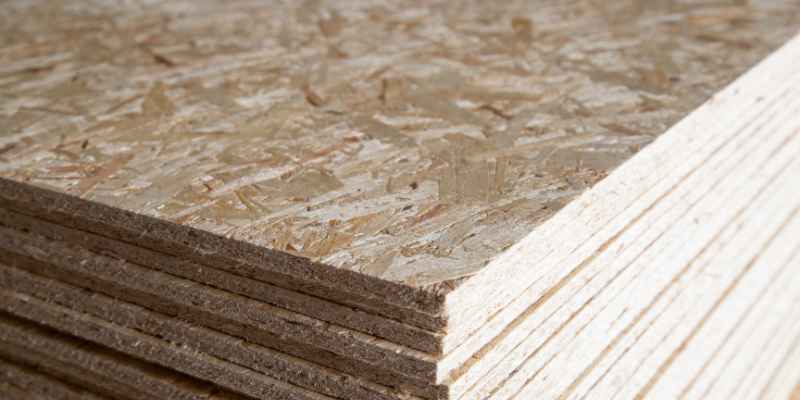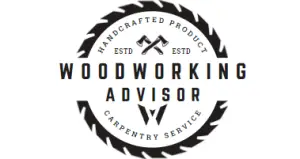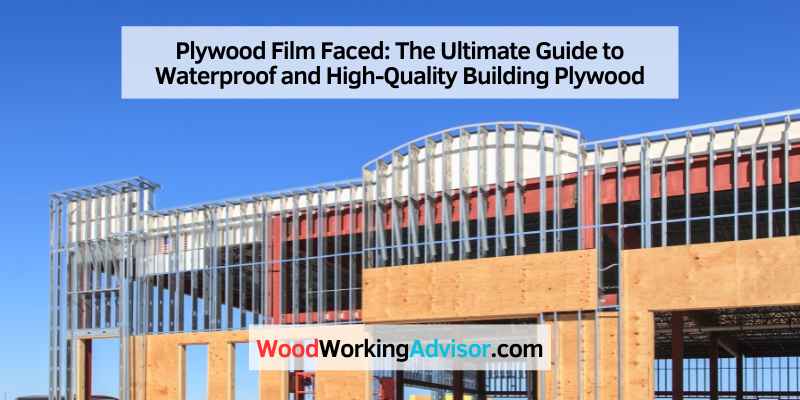Film-faced plywood is a strong exterior plywood used in building and construction projects. Its surface has a film coating which gives the plywood a higher resistance to moisture, abrasion, and fungal attacks compared to ordinary plywood.
Film-faced plywood is a durable and cost-effective solution for construction projects that require high-quality and sturdy materials. The plywood is available in different sizes and types, making it suitable for a variety of applications. This type of plywood is commonly used in concrete formwork, external walls, and flooring projects.
It is waterproof, which makes it ideal for outdoor use. Additionally, film-faced plywood can be painted with acrylic or oil-based paints to enhance its appearance and durability.
Introduction To Film Faced Plywood
Film faced plywood is an exterior plywood typically used in construction projects. It features a film coating on its surface, giving it an extra layer of protection against moisture, abrasion, and fungal attacks, making it more resistant than ordinary plywood.
If you are looking for a strong and durable plywood for your building or construction project, then you may want to consider film faced plywood. Film faced plywood is an exterior plywood that comes with a film coating on its surface, which enhances its strength and durability. This type of plywood is designed to resist moisture, abrasion, and fungal attacks. In this section, we will dive deeper into Film Faced Plywood with the following H3 headings: What is Film Faced Plywood? Advantages of Film Faced Plywood and Applications of Film Faced Plywood.

What Is Film Faced Plywood?
Film faced plywood is a type of exterior plywood that is commonly used in building and construction projects. It gets its name from the film coating, which is applied on the surface of the plywood in order to enhance its strength and durability. The film coating is typically made of phenolic resin, which is a synthetic polymer that is known for its water-resistant properties. Film faced plywood is available in a variety of thicknesses and sizes to suit different building and construction needs.
Advantages Of Film Faced Plywood
There are several advantages of using film faced plywood in building and construction projects. Some of the key advantages are:
- Durability: Film faced plywood is highly durable and able to withstand external factors such as moisture and abrasion.
- Water-resistant: The film coating on the plywood’s surface makes it resistant to water and the risk of fungal attacks.
- Ease of use: Film faced plywood is easy to cut and handle, making it simple to work with and therefore saving on time and labour costs.
- Cost-effective: Film faced plywood is typically more affordable than other types of exterior ply and is readily available, making it a good choice for many budgets.
Applications Of Film Faced Plywood
Film faced plywood is used in a wide range of building and construction applications. Its ability to withstand external factors makes it perfect for outdoor use, such as for concrete formwork, flooring, walls, scaffolding, and roofing. It is also popular in the transportation industry for the construction of truck and container floors, as well as for shipbuilding. Additionally, film faced plywood is an excellent choice for furniture and interior design projects due to its durability and moisture resistance.
Film faced plywood offers a range of advantages over other types of timber. Its resistance to moisture, abrasion, and fungal attacks, makes it the perfect choice for outdoor construction projects that require durability and longevity. Its versatility in terms of applications and sizes truly make it a valuable asset for any construction project.
Types Of Film Faced Plywood
Film faced plywood is a type of exterior plywood that is coated with a durable film layer, giving it better resistance to moisture, abrasion, and fungal attacks. This makes it a popular choice for building and construction projects where strength and durability are key factors.
There are different types of film faced plywood available in the market that cater to different needs and requirements.
Film faced plywood is a popular choice for construction and building projects due to its durable and moisture-resistant surface. There are several types of film faced plywood that are available, including:
Phenolic Film Faced Plywood
Phenolic film faced plywood is made with a phenolic resin coating on both sides and has a smooth and glossy finish. It has excellent weather and abrasion resistance properties, making it ideal for use in outdoor applications, flooring, and concrete formwork. This type of plywood is also available in various colors and finishes to suit different project requirements.
Melamine Film Faced Plywood
Melamine film faced plywood has a melamine resin coating on both sides and comes in a wide range of finishes, colors, and patterns such as wood grain, marble, and abstract designs. It is lightweight, easy to handle, and highly resistant to scratches, stains, and moisture. Melamine film faced plywood is commonly used in furniture, cabinets, and decorative applications.
Acrylic Film Faced Plywood
Acrylic film faced plywood has an acrylic resin coating on both sides and has a smooth and glossy finish. It is highly resistant to UV rays, weather, and chemical agents, making it ideal for use in outdoor applications such as cladding, roofing, and fascias. This type of plywood is also available in various colors and designs to match the aesthetic requirements of a project.
Overall, film faced plywood is a versatile material that can be used for a wide range of applications. By choosing the appropriate type of film faced plywood that matches your project’s requirements, you can ensure that your construction or building project will be long-lasting and of high quality.
Factors To Consider When Choosing Film Faced Plywood
When choosing film faced plywood for building or construction projects, it is important to consider factors such as the quality of the plywood, the thickness and weight, the type and quality of the film, and the level of water resistance needed.
Film faced plywood is a strong exterior plywood with a film coating that provides higher resistance to moisture, abrasion, and fungal attacks compared to ordinary plywood.
Film faced plywood is a favorite among construction professionals due to its strength and durability. However, not all film faced plywood is created equal. There are factors to consider when selecting the right product for your project. Here are some of them:
Water Resistance
One of the primary advantages of film faced plywood is its water resistance. This feature makes it ideal for use in outdoor construction projects. When selecting a film faced plywood, ensure that it has a high level of water resistance. This factor is critical in ensuring that your plywood lasts long and doesn’t rot or become weak when exposed to moisture.
Strength And Durability
Film faced plywood is known for its strength and durability. It is vital to choose a film faced plywood with high-density fiberboard (HDF) that can handle heavy loads and withstand outdoor elements. Check the thickness of the plywood sheet as this affects its strength. Additionally, ensure that it has been treated to resist mold and termites, which are common problems in outdoor construction.
Film Coating Quality
The film coating is the outer layer of the film faced plywood. It protects the plywood from weather damage, scratching, and wear and tear. It’s essential to choose a film faced plywood with a high-quality film coating that is smooth and free of defects. Inspect the surface of the plywood for bubbles, creases or cracking that may weaken the film’s waterproofing abilities.
Cost
The cost of film faced plywood depends on the type of wood used, thickness, and the quality of the film coating. It’s essential to consider your project budget when selecting a film faced plywood. However, don’t compromise on quality over cost. Choosing a substandard plywood with a weaker film coating may result in costly repairs or replacements in the future.
Environmental Impact
When selecting any construction materials, it’s important to consider its environmental impact. Choose film faced plywood made from sustainably sourced wood and that adheres to environmental regulations. Some manufacturers may use advanced eco-friendly film coatings that are low in volatile organic compounds (VOCs), which can cause respiratory issues.
In conclusion, choosing the right film faced plywood for your project requires careful consideration. Consider its water resistance, strength, and durability, film coating quality, cost, and environmental impact. With the right choice, you’ll optimize the value for your project and avoid costly repairs or replacements.
Film Faced Plywood Production Process
The production process of film faced plywood involves coating the plywood surface with a film to increase its resistance to moisture, abrasion, and fungal attacks. This makes it suitable for building and construction projects, especially for concrete form work, where a waterproof surface is required.
Raw Material Preparation
The first step in producing film faced plywood involves the preparation of raw materials. High-quality wood, such as birch or eucalyptus, is carefully selected to ensure that the resulting plywood is strong and durable. The wood is then cut into thin, uniform sheets, known as veneers, using a rotary lathe or a slicing machine. These veneers are then sorted by grade and size to ensure that only the highest quality materials are used.
Gluing Of Layers
To create strong and durable film faced plywood, several layers of veneer are glued together using a high-strength adhesive. The orientation of each layer is carefully selected to maximize strength and stability, with the grain of each layer running perpendicular to the adjacent layers. This cross-grain construction ensures that the plywood is resistant to warping and cracking.
Hot Pressing
Once the layers of veneer are glued together, they are placed in a hot press. The press applies heat and pressure to the plywood, activating the adhesive and bonding the layers together. The temperature and pressure used in this process depend on the type of wood used, with some species requiring higher temperatures and pressures than others.
Film Coating Application
After hot pressing, the plywood is coated with a film to protect the surface from moisture, abrasion, and fungal attacks. The film is typically made from phenolic resin or melamine, which are known for their durability and resistance to water and chemicals. The film is applied using a special machine that ensures a uniform and consistent coating.
Cutting And Finishing
Once the film has been applied, the plywood is trimmed to size and sanded to achieve a smooth surface. The final product is then ready for use in a wide range of building and construction applications, including concrete formwork, scaffolding, flooring, and exterior cladding.
In conclusion, the film faced plywood production process involves the careful selection and preparation of high-quality raw materials, the gluing of layers in a cross-grain construction, hot pressing with heat and pressure, the application of a film coating and cutting and finishing of the final product. This process ensures that film faced plywood is strong, durable, and resistant to moisture, abrasion, and fungal attacks, making it ideal for use in a wide range of construction applications.
Importance Of Proper Handling And Storage Of Film Faced Plywood
Proper handling and storage of film faced plywood is essential for its durability and performance. The film coating on the plywood’s surface makes it ideal for resisting moisture, abrasion, and fungal attacks. Keeping it in a dry, well-ventilated area and avoiding stacking heavy objects on top of it can help prolong its lifespan and maintain its quality.
Preventing Moisture Damage
Film Faced Plywood is highly resistant to moisture, but it is crucial to protect it from extended exposure to water. Even though the plywood’s exterior film gives it a smooth finish to keep out moisture, you need to take additional measures to safeguard it during storage and transportation. Be sure to keep the plywood in a dry room with enough air circulation to prevent mold or fungal growth.
Avoiding Physical Damage
Film Faced Plywood is highly resilient, but it is subject to physical damage. It may cause bubbles on the film face or damage the edges of the plywood sheets. Therefore, you should take steps to prevent splitting or chipping during handling or transportation. It is essential to keep the plywood stacked flat and not bend or twist it while moving it. Be sure that the sheets are appropriately supported from beneath while handling and that stacking does not exceed the recommended height.
Storing On A Level Surface
Storage is critical in maintaining the quality of Film Faced Plywood. Safe storing is essential to ensure that the plywood retains its shape, and that it’s not affected by uneven pressure. It is crucial to store the plywood on a level surface to avoid warping or bowing. In addition, be sure to stack it safely and carefully so that it is not crowded and does not lose its shape. If you need to store it for an extended period, you should incorporate ventilation by creating gaps between the stacks to promote proper air circulation.
Proper handling and storage can make all the difference in ensuring that Film Faced Plywood retains its quality and integrity. Take the necessary steps to protect your investment, and you will enjoy extended value and functionality from your plywood.
Common Uses Of Film Faced Plywood In Building And Construction
Film faced plywood is widely used in building and construction due to its high resistance to moisture, abrasion, and fungal attacks. The exterior plywood is coated with a film that makes it suitable for concrete formwork and other structural applications.
OptiPly and Baba Yapi are some of the well-known suppliers of film faced plywood.
Concrete Formwork
One of the most common uses of film faced plywood in building and construction is for concrete formwork. The film coating on the plywood ensures that it is completely water-resistant, making it an ideal material to use for foundations, columns, walls, and beams.
Roofing And Flooring
Film faced plywood is also used in roofing and flooring, especially in areas where high strength and durability are required. Its resistance to moisture and abrasion makes it an excellent material for exterior and interior flooring as well as roofing.
Exterior Cladding
Exterior cladding is another application of film faced plywood. It is used in situations where exceptional durability and strength are required. The film coating on the plywood ensures that it can withstand harsh weather conditions, making it an ideal material for buildings that are located in coastal areas or other areas that are exposed to high levels of moisture.
Furniture And Joinery
Film faced plywood is also used in the manufacturing of furniture and joinery due to its durability and strength. It can be used to make tables, chairs, cabinets, and other furniture pieces. The film coating on the plywood gives a smooth surface, which makes it easier to paint, stain, or varnish.
Packaging And Shipping
Due to its strength and durability, film faced plywood is also widely used in the packaging and shipping industries. It can be used to make crates, pallets, and other packaging materials for transporting heavy goods over long distances. Its resistance to moisture and abrasion also ensures that the packaged goods are protected during transit.
In conclusion, film faced plywood is an essential material in the building and construction industry due to its durability, strength, and moisture resistance. Its versatility makes it suitable for a wide range of applications, from concrete formwork to exterior cladding, and even packaging and shipping.
Comparison Of Film Faced Plywood With Other Building Materials
Film faced plywood is a popular and strong exterior building material that is resistant to moisture, abrasion, and fungal attacks due to its film coating. This makes it a popular choice for construction projects where durability and weather resistance is important.
Compare to ordinary plywood, film faced plywood is a higher quality choice for long-lasting building projects.
When it comes to building materials, there are several options to choose from including ordinary plywood, solid wood, metal and plastic sheets. In this article, we will be comparing film faced plywood with these other materials to determine which is the best choice for construction projects.
Comparison with Ordinary Plywood
Ordinary plywood is a popular choice for construction projects, but it falls short in terms of durability when compared to film faced plywood. Film faced plywood has a film coating that provides a higher resistance to moisture, abrasion and fungal attacks which makes it a better option for outdoor constructions. Additionally, film faced plywood can be reused multiple times, which makes it an economical choice in the long run.
Comparison with Solid Wood
Solid wood is a traditional building material that has been used for centuries. However, it has certain limitations when it comes to construction projects, particularly when it comes to strength and durability. Film faced plywood, on the other hand, has high strength and a smooth surface which makes it an ideal option for heavy-duty constructions. It is also more cost-effective compared to solid wood.
Comparison with Metal and Plastic Sheets
Metal and plastic sheets are commonly used in construction projects due to their durability and strength. However, they can be expensive and difficult to work with. Film faced plywood is a more affordable option that offers similar levels of strength and durability. It is also easier to work with and can be cut to fit any shape or size needed for the construction project.
In conclusion, film faced plywood offers superior durability, strength and cost-effectiveness when compared to other building materials. It is an excellent choice for construction projects that require high levels of strength and durability while still remaining economical in the long run.

Frequently Asked Questions Of Plywood Film Faced
What Is Film Faced Plywood?
Film faced plywood is a type of strong exterior plywood used in building and construction projects. It has a film coating on its surface that makes it more resistant to moisture, abrasion, and fungal attacks than ordinary plywood. The film coating also makes it suitable for use in concrete formwork.
Additionally, it is resistant to water and can be painted with durable acrylic latex or oil-based paints.
Is Film Faced Ply Waterproof?
Yes, film faced plywood is waterproof. Its surface has a film coating which provides higher resistance to moisture, abrasion, and fungal attacks compared to ordinary plywood. Film faced plywood is commonly used in building and construction projects, especially for concrete form work where water resistance is essential.
Can Film Faced Plywood Be Painted?
Yes, film faced plywood can be painted. It is recommended to choose a paint that will increase the durability of the material. Durable acrylic latex paints and oil-based paints are suitable for furniture and general usage areas. It is important to select the paint according to the work to be done.
Baba Yapı suggests using Film-Faced Plywood for different purposes.
Is Spectre Film Faced Plywood Waterproof?
Yes, Spectre film faced plywood is waterproof as it has a film coating that gives it a higher resistance to moisture, abrasion, and fungal attacks compared to ordinary plywood. It is a great choice for outdoor use as it is water-resistant, lightweight, and corrosion-resistant.
Additionally, its edges are painted waterproof, making it suitable for various outdoor projects.
Conclusion
To wrap up, Film Faced Plywood is a highly durable construction material widely used in the building industry due to its resistance to moisture, abrasion, and fungal attacks. As previously mentioned, its surface is coated with a film that provides high-performance features, making it an ideal choice for outdoor use.
Film faced plywood is more robust and sturdier than regular plywood, which means it’s bound to last longer. Whether you’re building a house, a high-rise building or even a bridge, using Film Faced Plywood is an efficient way to ensure the longevity and sturdiness of your construction.

